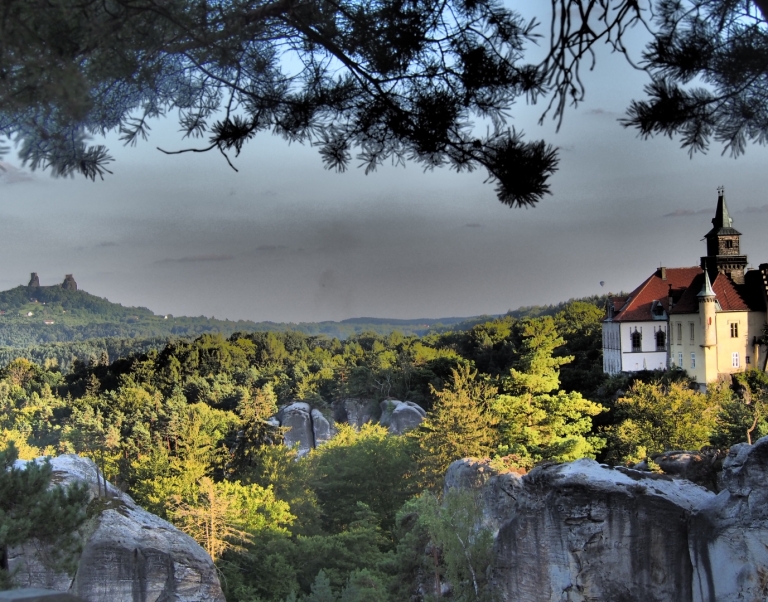Bohemian Paradise

Hrubá Skála Chateau
-
Hits: 11001
HRUBÁ SKÁLA CHATEAU
The Hruboskalsko is one of the best-known rock formations. It is characterised by impressive towers reaching up to 55 m and also by steep canyons
Hrubá Skála chateau
The Skála castle was founded sometime before 1353 probably by Hynek of Wallenstein. His descendants owned the castle until 1416, when the lords of Jenstein took over followed by Zajíc of Hasenburgs in 1460.
Being the member of Zelenohorská jednota, Jan Zajíc of Hasenburg stood up against king Jiří and as a retaliation, the castle was besieged and conquered by the king's army. In 1492 the castle was taken over by the line of Svojanovský of Boskovice, who have extended the Skála manor to about 54 villages and hamlets. Jan Svojanovský subsequently fell into debt and was forced to sell the manor out part by part to Zikmund Smiřický of Smiřice, the last part being the castle itself in 1524. Zikmund Smiřický (died in 1548) and his descendants have further extended the estate and rebuilt the old gothic castle into a three-wing Renaissance chateau. In 1618, Albrecht Jan Smiřický stood up actively against emperor Ferdinand, which would certainly gain him a death sentence after the uprising having been suppressed. He died in November 1618 before that could happen and as his oligophrenic brother Jindřich Jiří was the manor's undeniable co-owner, the manor was not then confiscated, but went under the control of his custodian, Albrecht of Wallenstein. Jindřich Jiří died at Hrubá Skála in 1630 and the manor remained in the hands of Albrecht of Wallenstein, being thus affiliated with Albrecht's duchy of Frýdlant.
After Albrecht's assassination in Cheb in 1634, Maxmillian of Wallenstein has become the new owner of Skála. During the thirty-year war the chateau suffered significantly. Right after the death of Albrecht of Wallenstein it was robbed both by the Saxons and the imperial army, then taken over by a Swedish garrison only to be won back by Colloredo's imperial troops in 1639. Later on, in 1643, they were forced out again by the Swedish under the command of general Torstenson. Of course, in such a turmoil the manor of Hrubá Skála suffered immensely, lot of villages being burnt down or abandoned. Maxmillian of Wallenstein spent the rest of his life in Vienna until his death in 1655. By the emperor's ruling in 1658, along with other castles Hrubá Skála was to be taken down not to serve as an outpost for the enemy in case of possible future war. Skála was eventually saved following protests of Maximillian's grandson Arnošt Josef of Wallenstein, which probably made the emperor change his mind. In 1710 and 1804 the chateau was damaged by fire but mended again in both cases by the Wallensteins. František Adam, the last of the Wallensteins, sold Skála and the entire manor to Jan Lexa of Aerenthal in 1821. The Aerenthals were good landlords who have been amending their castles and chateaus slightly in the manner of romantism. They have had the Hrubá Skála rebuilt in a neo-gothic style. Aloys count Lexa of Aehrenthal was the minister of Austria-Hungarian foreign affairs. The chateau was then confiscated by the state in 1945. Shortly after that the communist unions have taken over to have the premises adapted to recreational facilities. In that process, the chateau interiors have unfortunately undergone an irreparable damage.
Trosky
Trosky is called the symbol or landmark of Bohemian Paradise for its unique appearance and origin. The castle ruin is one of the most visited sights of the Czech Republic. In addition to the standard tours, the castle administration also offers night tours of this National Monument and weekends focused on families with children. Trosky is accessible in season from Tuesday to Sunday, in July and August
History of the Trosky Castle
The bizarre ruins of a Gothic castle founded in the late 14th century by the Lords of Wartenberg became one of the main symbols of the whole Bohemian Paradise area. The siting of the castle on two steep basalt volcanic made Trosky unconquerable - even the Hussites failed to capture it. However, no fortress can resist the hands of time, so even Trosky, abandoned in the late 15th century, began to gradually fall into ruin. However thanks to its romantic atmosphere and unique silhouette it became a popular tourist destination in the 19th century and soon received the most necessary repairs. Visitors today learn about the rich history of the castle, climb up the Baba tower and up to the outlook under Panna tower.
















